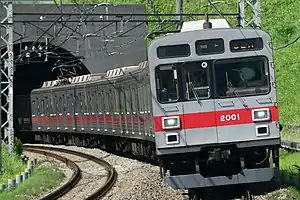Tokyu 2000 series
The Tokyu 2000 series (東急2000系, Tōkyū 2000-kei), reclassified Tokyu 9020 series (東急9020系, Tōkyū 9020-kei) from 2019, is a Japanese commuter electric multiple unit (EMU) train type operated by Tokyu Corporation in the Tokyo area since 1992. They were used on Tokyu Den-en-toshi Line and Tokyo Metro Hanzomon Line inter-running services from 1992 until 2018,[1] as well as the Tokyu Oimachi Line since 2018. Three 10-car sets were built by Tokyu Car Corporation between 1992 and 1993, all of which were shortened to 5-car sets by March 2019.
| Tokyu 2000/9020 series | |
|---|---|
 A 2000 series set on the Den-en-toshi Line | |
| In service | 1992–present |
| Manufacturer | Tokyu Car Corporation |
| Constructed | 1992–1993 |
| Entered service | 29 March 1992 |
| Refurbished | 2018–2019 |
| Number built | 30 vehicles (3 sets) |
| Number in service | 15 vehicles (3 sets) |
| Number scrapped | 15 vehicles |
| Formation | 5 (formerly 10) cars per trainset |
| Fleet numbers | 9021–9023 |
| Operator(s) | Tokyu Corporation |
| Depot(s) | Nagatsuta |
| Line(s) served |
|
| Specifications | |
| Car body construction | Stainless steel |
| Car length | 20,000 mm (65 ft 7+3⁄8 in) |
| Width | 2,800 mm (9 ft 2+1⁄4 in) |
| Doors | 4 pairs per side |
| Maximum speed | service: 110 km/h (68.4 mph) design: 120 km/h (74.6 mph) |
| Traction system | (Before Refurbishment) GTO-VVVF (After Refurbishment) SiC-VVVF |
| Acceleration | 3.3 km/(h⋅s) (2.1 mph/s) |
| Deceleration | 3.5 km/(h⋅s) (2.2 mph/s) (service) 4.5 km/(h⋅s) (2.8 mph/s) (emergency) |
| Electric system(s) | 1,500 V DC Overhead wire |
| Current collector(s) | Pantograph |
| Safety system(s) | CS-ATC |
| Track gauge | 1,067 mm (3 ft 6 in) |
Operations
These sets are used on the Tokyu Oimachi Line.[1] Originally, they were used on Tokyu Den-en-toshi Line and Tokyo Metro Hanzomon Line inter-running services; they were not capable of running through onto the Tobu Skytree Line, and had circular "K" stickers on the centre front cab window to indicate this.[2]
Design
Based on the earlier Tokyu 9000 series EMU design, two sets were introduced in 1992, followed by a third in 1993.[2] The first two sets were delivered with roller blind destination indicators, whereas the third set was delivered from new with 3-colour LED destination indicators.[2] All three sets have since been modified with full-colour LED destination indicators.[2]
Formations
Den-en-toshi Line 10-car sets
The 10-car sets consisted[1] of six motored (M) cars and four unpowered trailer (T) cars, formed as shown below, with car 1 at the Shibuya end.[3][4]
| Car No. | 1 | 2 | 3 | 4 | 5 | 6 | 7 | 8 | 9 | 10 |
|---|---|---|---|---|---|---|---|---|---|---|
| Designation | Tc2 | M2 | M1 | T2 | M2 | M1 | T1 | M2 | M1 | Tc1 |
| Numbering | 2000 | 2250 | 2200 | 2700 | 2350 | 2300 | 2800 | 2450 | 2400 | 2100 |
| Weight (t) | 27.8 | 33.1 | 34.7 | 26.2 | 33.1 | 34.7 | 27.2 | 33.1 | 34.7 | 27.8 |
| Capacity (total) | 130 | 144 | 130 | |||||||
Cars 3, 6, and 9 were each fitted with one lozenge type pantograph.[4] Cars 3 and 9 had wheelchair spaces.[3]
Interior
Passenger accommodation consists of longitudinal bench seating throughout.[2]
 Interior view
Interior view Interior view of car 3, showing the wheelchair space
Interior view of car 3, showing the wheelchair space
History
The first two sets entered service on the Den-en-toshi Line in September 1992, with a third following in 1993.[2]
Oimachi Line transfer and reclassification
Set 2103 was the first set to be transferred to the Oimachi Line; it was introduced on the line in 2018 as a 5-car formation.[5] By February 2019, 2000 series sets 2102 and 2103 were in service on the Oimachi Line, with set 2102 being shortened to a 5-car formation as well; they were reclassified "9020 series" and respectively numbered 9022 and 9023.[5]
Set 2101 was transferred to the Oimachi Line in March 2019; like the other sets, it was shortened to 5 cars and was renumbered 9021.[1]
Fifteen surplus cars were scrapped in 2018.[1]
 Set 2102 on the Den-en-toshi Line, with original roller blind destination indicators and no front end skirt, November 2004
Set 2102 on the Den-en-toshi Line, with original roller blind destination indicators and no front end skirt, November 2004 9020 series set 9021 (formerly 2101) on the Oimachi Line, December 2021
9020 series set 9021 (formerly 2101) on the Oimachi Line, December 2021
References
- "東急電鉄 長津田検車区編成表" [Tokyu Nagatsuta Zone Formation Tables]. formation.g1.xrea.com. Retrieved 19 December 2021.
- 私鉄車両年鑑2012 [Japan Private Railways Annual 2012]. Tokyo, Japan: Ikaros Publications Ltd. February 2012. p. 143. ISBN 978-4-86320-549-9.
- 私鉄車両編成表 2012 [Private Railway Rolling Stock Formations – 2012]. Japan: JRR. July 2012. p. 68. ISBN 978-4-330-29911-2.
- Watanabe, Mineo (May 1992). "東急2000系" [Tokyu 2000 series]. Japan Railfan Magazine. Vol. 32, no. 373. Japan: Koyusha Co., Ltd. pp. 29–33.
- Hirose, Atsushi (18 February 2019). "東急2000系改め,9020系が登場" [Tokyu 2000 series reclassified as 9020 series]. Japan Railfan Magazine Online (in Japanese). Retrieved 4 December 2021.
